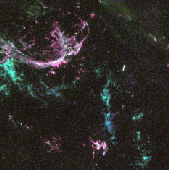
Supernova Remnants Page
![]()
Although many stars like our sun can remain stable for billions of years, more massive stars can race through their entire life cycles in a relatively short 10 million years or so, ending in a cataclysmic explosion called a supernova that literally tears the aging star apart. A supernova remnant is the expanding gaseous nebula created by these titanic explosions. Supernova remnants are of interest to many areas of astrophysics.
 HST Image of a Young SNR known as
HST Image of a Young SNR known as
N132D in the Large Magellanic Cloud.
(Click photo to see a larger version.)
Young supernova remnants (less than a few thousand years after the SN explosion) still show large enrichments from the heavy elements that were created deep inside the star before it exploded. The image above, taken with the WFPC2 camera on the Hubble Space Telescope, shows this graphically. The red and white material in the image is "normal" interstellar material that has been struck by the SN shock wave and heated to the point that is gives off light. The aqua and blue material, however, emits only in the lines of oxygen, and represents nearly pure material from the interior of the star that exploded! (Literally, Carl Sagan's "star stuff," if you will!) Observations of the light from these objects provides our only direct test of the process of nucleosynthesis, whereby lighter elements are fused into heavier elements in the centers of stars.
 HST Image of a Small Section of the
HST Image of a Small Section of the
Cygnus Loop SNR in our Galaxy. This
object is much older, and only interstellar gas
is seen.
(Click photo to see a larger version.)
Some supernova remnants remain visible for tens of thousands of years before finally blending back into the general interstellar medium, or tenuous gas in the regions between the stars. The image above shows a small section of the Cygnus Loop, the remnant of an explosion from perhaps 25,000 years ago! Here the different colors tell us that the speed of the shock wave changes as the shock encounters material of different densities in interstellar space. i
As a supernova shock wave travels outward from the point of the explosion, it sweeps up the gas of the interstellar medium into a roughly spherical, expanding shell. This gas "glows" because of heating from particle collisions. The light given off from these objects spans the entire electromagnetic spectrum from X-rays and ultraviolet light through the optical, infrared and radio. Analysis of this light provides information on the chemical composition and physical conditions (temperature, density, and variations thereof) in these normally invisible regions of interstellar space. Hence, supernova remnants can be used as probes of the structure of the interstellar medium, as well as providing information on the physics of shock waves in conditions much different from those that can be created in a laboratory on earth.
Shock waves from supernovas play an important role in energizing the interstellar medium and by compressing clouds of gas and dust in the interstellar medium may be responsible for starting new cycles of star formation. (Click here for an image and further description.)
![]()
William P. Blair Return to Bill Blair's Research page.
Return to Bill Blair's home page.